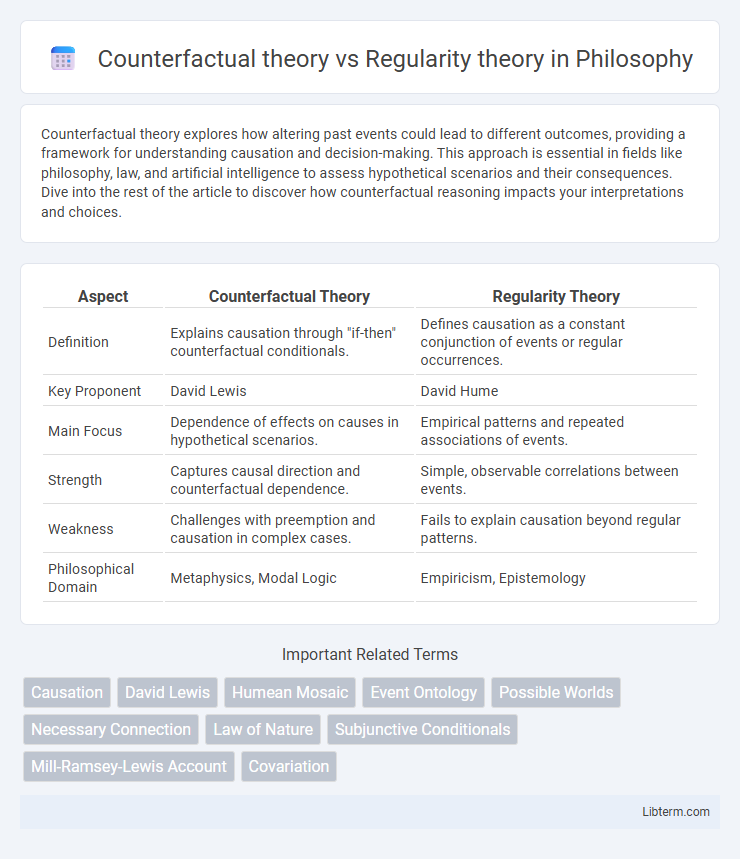Counterfactual theory explores how altering past events could lead to different outcomes, providing a framework for understanding causation and decision-making. This approach is essential in fields like philosophy, law, and artificial intelligence to assess hypothetical scenarios and their consequences. Dive into the rest of the article to discover how counterfactual reasoning impacts your interpretations and choices.
Table of Comparison
| Aspect | Counterfactual Theory | Regularity Theory |
|---|---|---|
| Definition | Explains causation through "if-then" counterfactual conditionals. | Defines causation as a constant conjunction of events or regular occurrences. |
| Key Proponent | David Lewis | David Hume |
| Main Focus | Dependence of effects on causes in hypothetical scenarios. | Empirical patterns and repeated associations of events. |
| Strength | Captures causal direction and counterfactual dependence. | Simple, observable correlations between events. |
| Weakness | Challenges with preemption and causation in complex cases. | Fails to explain causation beyond regular patterns. |
| Philosophical Domain | Metaphysics, Modal Logic | Empiricism, Epistemology |
Introduction to Causation Theories
Counterfactual theory of causation analyzes cause-effect relationships by evaluating whether altering a cause would change the effect, emphasizing hypothetical scenarios and dependency conditions between events. Regularity theory defines causation through constant conjunctions, asserting that a cause is regularly followed by an effect, focusing on observable patterns and constant correlations in events. Both theories aim to explain the nature of causation but differ in their approach: counterfactuals rely on conditional statements about alternate realities, while regularity theory depends on empirical regularities.
Defining Counterfactual Theory
Counterfactual theory defines causation by analyzing hypothetical scenarios where altering a cause would change its effect, emphasizing "if-then" dependencies to explain causal relationships. This theory contrasts with Regularity theory, which identifies causation based on consistent patterns or repeated associations between events. By focusing on possible worlds and conditional statements, Counterfactual theory provides a more nuanced framework for causal inference beyond mere correlation.
Understanding Regularity Theory
Regularity theory defines causation based on the consistent conjunction of events, stating that cause and effect occur together regularly or constantly; this empirical approach emphasizes observable patterns rather than hypothetical scenarios. It identifies causal relationships by noting that whenever the cause occurs, the effect follows, highlighting a dependable association without relying on counterfactual dependence. Understanding regularity theory involves recognizing its focus on repeated event sequences and systematic correlations as evidence for causal links in natural phenomena.
Historical Development and Key Philosophers
Counterfactual theory, prominently developed by David Lewis in the 20th century, emphasizes causation through the analysis of "what if" scenarios, marking a significant shift from earlier interpretations. Regularity theory, rooted in the works of David Hume in the 18th century, asserts that causation is the constant conjunction of events, relying on observable regular patterns rather than hypothetical alternatives. The historical development shows a progression from Hume's empirical skepticism to Lewis's formalized modal logic framework, reflecting evolving philosophical methods and perspectives on causality.
Core Differences Between Counterfactual and Regularity Theories
Counterfactual theory emphasizes causal relationships through conditional statements about what would happen if certain events occurred, whereas regularity theory relies on the consistent association of events in observed patterns without invoking hypothetical scenarios. Counterfactual theory handles causation by evaluating dependencies in possible worlds, contrasting with regularity theory's focus on actual repeated conjunctions of events in reality. This distinction highlights counterfactual theory's strength in addressing singular causation and explanatory contexts, while regularity theory provides a descriptive approach based on empirical regularities.
Advantages of Counterfactual Theory
Counterfactual theory excels in analyzing causation by capturing the dependency between events through "if-then" scenarios, allowing for a more precise understanding of cause and effect compared to regularity theory's reliance on mere constant conjunctions. It handles singular causation cases effectively, addressing problems like preemption and overdetermination that regularity theory struggles with. This theory's ability to incorporate context and consider alternative possibilities provides a nuanced and robust framework for causal analysis in philosophy and scientific investigation.
Strengths of Regularity Theory
Regularity Theory excels in its straightforward approach by basing causation on consistent and observable sequences of events, which facilitates empirical verification and practical analysis. Its reliance on patterns of regular occurrence makes it accessible for scientific investigation and aligns well with statistical methods in various disciplines. The theory's emphasis on observable regularities supports clear causal inference without requiring hypothetical scenarios or complex counterfactual reasoning.
Common Criticisms and Limitations
Counterfactual theory faces criticism for its dependence on hypothetical scenarios that can be ambiguous or context-sensitive, challenging its practical application in causal analysis. Regularity theory struggles with the problem of spurious correlations and fails to distinguish genuine causation from mere constant conjunctions, limiting its explanatory power. Both theories confront difficulties in addressing complex causal relationships involving multiple interacting factors and contingency.
Practical Applications in Philosophy and Science
Counterfactual theory, emphasizing "if-then" scenarios, guides decision-making in ethics and causal inference in scientific experiments by exploring hypothetical alternatives to actual events. Regularity theory, grounded in consistent patterns observed in nature, underpins empirical research methods and the formulation of natural laws, relying on the constant conjunction of events. Both theories influence practical applications: counterfactual reasoning enhances predictive modeling and moral responsibility assessments, while regularity theory supports hypothesis testing and the identification of reliable cause-effect relationships.
Conclusion: Which Theory Prevails?
Counterfactual theory prevails by offering a more nuanced understanding of causation through the analysis of hypothetical scenarios, allowing for clearer distinctions between cause and correlation. Regularity theory, while historically foundational, struggles with exceptions and fails to account for non-constant conjunctions, limiting its explanatory power. The practical application of counterfactual reasoning in fields like philosophy, law, and artificial intelligence further solidifies its dominance over regularity theory.
Counterfactual theory Infographic

 libterm.com
libterm.com